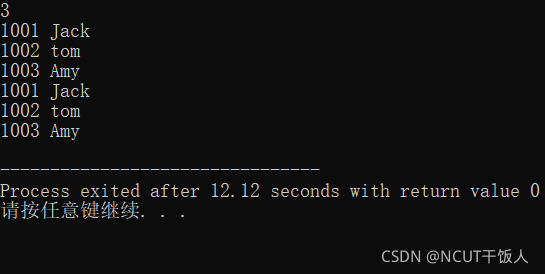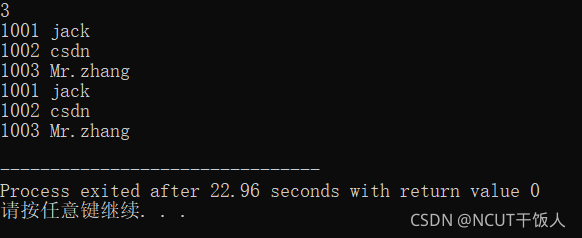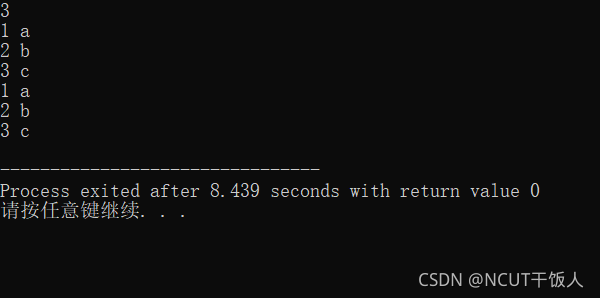C语言结构体数组常用的三种赋值方法(包含字符串)
目录
- 一、按照成员变量进行赋值(麻烦,好理解,字符串赋值需要strcpy)
- 二、对数组整体进行赋值。(一次性需要把所有的都添加进去,不需要strcpy)
- (1) 在声明数组的时候,进行赋值
- (2)对有规律的数据赋值,比如学生结构体的学号是有规律的。
- 三、使用输入进行赋值
- 总结
一、按照成员变量进行赋值(麻烦,好理解,字符串赋值需要strcpy)
这里使用了一个Init函数,为了在进一步说明传参的使用。实际上赋值按照需要放在主函数就行。
(使用strcpy函数需要添加头文件string.h)
#include <stdio.h>
#include <string.h>
typedef struct date //定义了一个日期结构体,包含年月日三个成员
{
int year;
int mouth;
int day;
}datea;
typedef struct schedule//定义了一个日程结构体,包含日期,和活动两个成员变量
{
char name[10];
datea date;
char activity[200];
}sch;
int Init(sch *name) //初始化函数 数组用指针接收
{
strcpy(name[0].name,"jack");
name[0].date.year = 2021; //使用级联运算
name[0].date.mouth = 11;
name[0].date.day = 11;
strcpy(name[0].activity,"Taobao shooping");
strcpy(name[1].name,"Amy");
name[1].date.year=2021;
name[1].date.mouth = 11;
name[1].date.day = 12;
strcpy(name[1].activity,"play piano");
}
int main()
{
sch name[2] ;
Init(name);
for(int i=0;i<2;i++)
{
printf("%s %d %d %d \n%s \n",name[i].name,name[i].date.year,name[i].date.mouth,name[i].date.day,name[i].activity);
}
}
二、对数组整体进行赋值。(一次性需要把所有的都添加进去,不需要strcpy)
(1) 在声明数组的时候,进行赋值
可以换行,中间的结构体嵌套需要再次使用花括号括起来(这里没有传参,放在被调函数不能这么赋值)。
sch name[2] = {{"jack",{2021,11,11},"Taobao Shopping"},
{"jack",{2021,11,11},"Taobao Shopping"}};
也可以直接写下去:
typedef struct student {
int sno;
char name[20];
} stu;
int main() {
stu stua[5] = {1001,"jack",1002,"Amy"};
输出结果:

这里举了个例子,定义了一维数组name,将name传到被调函数的时候,只剩下了首地址,对其进行赋值是[Error] declaration of 'sch name' shadows a parameter ,就是说缺少参数,因为只有首地址,并不是完整的数组,所以不能这么赋值。

(2)对有规律的数据赋值,比如学生结构体的学号是有规律的。
#include <stdio.h>
typedef struct student //定义了学生结构体
{
int sno;
char name ;
}stu;
stu stua[5]; //5名学生的结构体数组
int main()
{
for(int i=1;i<5;i++)
{
stua[i].sno=i; //循环赋值,5名学生的学号依次为1-5
}
return 0;
}
三、使用输入进行赋值
依然用学生为例子。
(1)直接使用for,配合动态分配内存,这里按照数据库的数据类型,我将学号定义为char型,实际上定义为int 即可。
#include <stdio.h>
#include <stdlib.h>
typedef struct student {
char sno[6];
char name[20];
} stu;
int main()
{
int N;
scanf("%d",&N);//获得学生个数
stu * stua = (stu *)malloc(N * sizeof(stua)); //动态分配了结构体变量stua的长度
//方法一:用for给结构体赋值
for(int i=0;i<N;i++)
{
scanf("%s %s",stua[i].sno,stua[i].name);
}
for(int i=0;i<N;i++)
{
printf("%s %s\n",stua[i].sno,stua[i].name);
}
}
输出结果:

(2)调用函数赋值,我们知道,结构体数组中,数组有多个元素,每个数组元素又有多个结构体成员变量,所以将每个数组元素用函数分别去赋值。
#include <stdio.h>
#include <stdlib.h>
typedef struct student { //定义结构体
char sno[6]; //注意学号为char
char name[20];
} stu;
stu getstu(void) //结构体函数
{
stu tem;
scanf("%s",tem.sno);//因为是字符串,不用加取址符&,否则此处为&p.x
scanf("%s",tem.name);
return tem;
}
int main()
{
int N;
scanf("%d",&N);//获得学生个数
stu * stua = (stu *)malloc(N * sizeof(stua)); //动态分配了结构体变量stua的长度
//方法二:调用函数
for(int i=0;i<N;i++)
{
stua[i] = getstu();
}
for(int i=0;i<N;i++)
{
printf("%s %s\n",stua[i].sno,stua[i].name);
}
}
输出结果:

(3)通过指针给到其他函数去赋值(如果你看到这,才到了精髓,传参赋值)
#include <stdio.h>
#include <stdlib.h>
typedef struct student { //定义结构体
char sno[6]; //注意学号为char
char name[20];
} stu;
void getstu(stu *stua) //返回值为空即可
{
scanf("%s",stua -> sno);//因为是字符串,不用加取址符&,否则此处为&stua.x
scanf("%s",stua -> name);
}
int main()
{
int N;
scanf("%d",&N);//获得学生个数
stu * stua = (stu *)malloc(N * sizeof(stua)); //动态分配了结构体变量stua的长度
//方法二:函数传参赋值
for(int i=0;i<N;i++)
{
getstu(&stua[i]);
}
for(int i=0;i<N;i++)
{
printf("%s %s\n",stua[i].sno,stua[i].name);
}
}
执行结果:

总结
到此这篇关于C语言结构体数组常用的三种赋值方法的文章就介绍到这了,更多相关C语言结构体数组赋值内容请搜索我们以前的文章或继续浏览下面的相关文章希望大家以后多多支持我们!
赞 (0)

